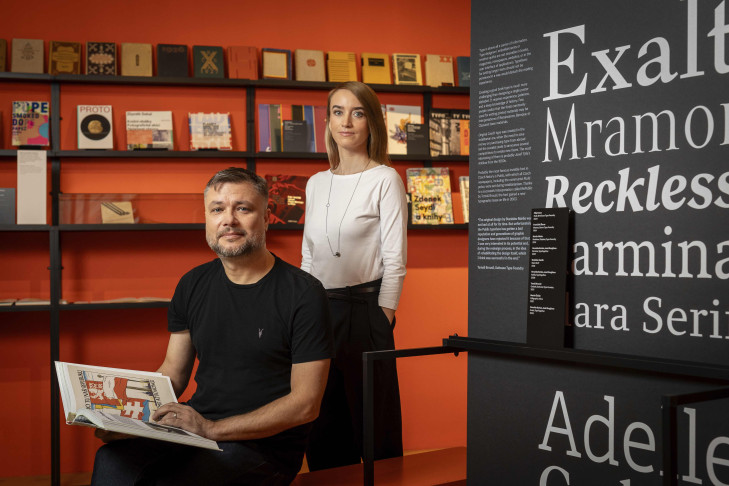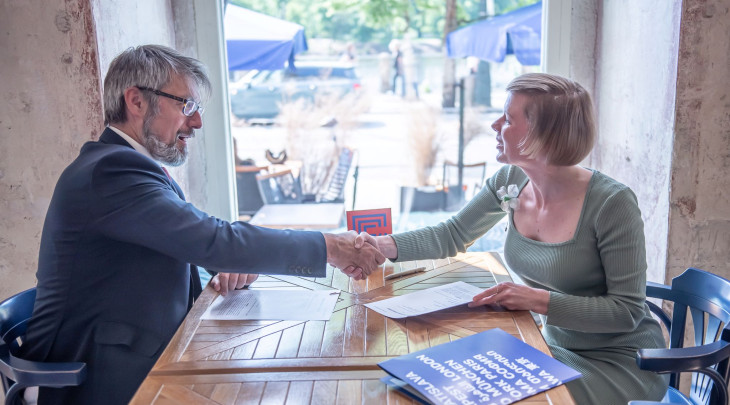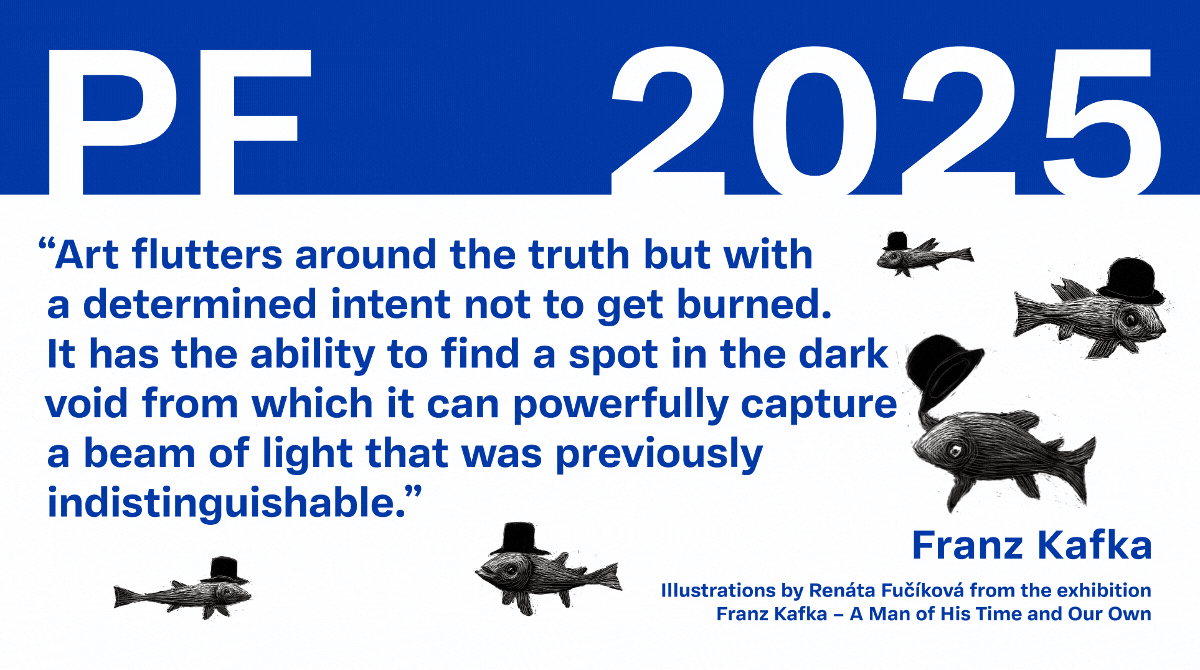Interview with the authors of the Identity exhibition – the story of Czech graphic design
- 07. 07. 2025
- News
- 6 minute read

The exhibition on Czech graphic design, prepared by Filip Blažek and Linda Kudrnovská, is part of the multi-format project Identity – The Story of Czech Graphic Design (www.projektidentita.cz) which includes a television series broadcast by the Czech Televisions, a featured film, an exhibition and an accompanying book of the same name. It was published at the occasion of the exhibition in Czech and English versions and serves as a monograph of Czech graphic design.
Partners of the exhibition include Czech Centres and embassies, thanks to whom the project will be presented aborad. The exhibition was on display until the end of June at the Czech Centre in London, and it will move to the Czech Centre in Taipei or Tokyo and then to Hong Kong.
Linda Kudrnovská, design theoretician, worked from 2002 to 2012 as editor-in-chief of Typo magazine focusing on graphic design, typography and visual communication. She is a frequent contributor to a number of European design magazines, a judge of international competitions and a long-term member of the board of the international typographic organisation ATypI.
Filip Blažek is a renowned Czech curator and designer who has been involved in international presentations of Czech graphic design. His name is associated with numerous projects that present Czech design in a global context.
The Identity project combines an exhibition, a film,a television series and a book. How do you view the power of this connection across media? In your opinion, does it open up new possibilities for the audience to appreciate the meaning and tradition of graphic design?
LK: Linking the individual media was our intention from the very beginning, because thanks to that it is possible to tell the story of Czech graphic design to a wide range of viewers – from enthusiastic amateurs to experts. The individual media conveyed a satisfactory part of the topic to the audience – the television viewer did not have to leave the comfort of his armchair and those whole wanted more depth could visit the exhibition and buy the monograph.
Moreover, the individual media complemented each other well and presented specific segments of graphic design in a decent way. For example, the book includes a chapter on digital design, but the topic is presented a bit better on screen.
The exhibition was successfully presented to the Czech public at the turn of the year in the Museum Kampa. Did you notice any specific exhibit or story in the feedback from visitors that particularly caught their attention?
FB: The illuminated information panels from the Prague metro were certainly among the most popular exhibits. Visitors realised that specific people people were behind them and that their appearance and function reflected the time of their creation.
LK: One of the visitor's favourites was the maquette of the Czechoslovak flags, which demonstrated the visual path of Czechoslovak and later Czech statehood which could have evolved quite differently if the jury had chosen a different flag in 1920.
What does the Identity exhibition mean to you personally? Is there anything that is particularly close to you – either professionally or personally?
FB: I saw the exhibition as a great chance to show that Czech graphic design has continuity, depth and often world-class level. And at the same time, it makes sense to talk about it not only as an aesthetic, but also as cultural and social phenomenon. I also enjoyed how we combined the iconic pieces of art with the almost unknown ones in the exhibition.
In collaboration with the Czech Centres, the Identity exhibition embarks on a cultural journey across continents – from London to Taipei to Tokyo. In your experience, how do foreign audiences react to Czech graphic design? What makes it specific or surprising?
FB: I think that Czech design looks authentic. They do not boast of greatness, but often surprise with wit, quality typography, or insight irony and humour.
LK: Foreign audiences are often surprised by how many interesting things were created in Czechoslovakia even at the time when technical and expressive possibilities were significantly limited. They are surprised that even in times where the people had little freedom, some artists managed to create timeless works despite the regime. It may also be surprising that the level of contemporary Czech graphic design often surpasses Western European graphic design in many areas such as book design or type design, and is of comparable quality overall.
What was the reaction to the exhibition in London? Did it meet your expectations? What surprised or delighted you?
LK: We were pleased to see the interest when the exhibition opened, it was really overflowing. It was not only people who are usually interested in the Czech Centre's activities, but also many people from the graphic community. Renowned designers from the Czech Republic and London participated in complementary programmes which further encouraged the interest in the exhbition.
You have worked on numerous projects. How did the work on Identity differ from your previous project?
FB: It was work for four different media – televsion, exhibiton, publication and film – and it was interdisciplinary at the same time. This required great openness, the will to compromise and the ability to commincate with different types of professionals. Furthermore, the project was initiated bottom-up, without an institutuional mandate, which gave us freedom but also great responsability.
In your opinion, what do you think visitors who do not have a background of Czech visual culture should take away from the foreign presentation of the exhibition?
FB: I think visitors should realise that graphic design is not only aesthetic, but also a cultural and social phenomenon. Czech design tells its own stories, that reflect our history, mentatlity and way of thinking. And also that behind visual culture there is always a community of specific people.
LK: I hope that they include the Czech Republic on the imaginary world map of quality graphic design. Graphic design, typography and font creation are indeed one of our major soft powers and design diplomacy should be used much more widely as a country. The Czech Republic is not just crystal, beer and Krteček (a cartoon mole).
What do you think the future of the presentation of Czech graphic design abroad should ideally look like?
LK: It should focus on breaking stereotypes. All the connoisseurs abroad will know Alfons Mucha, so it is necessry to spread awareness of the quality of Czech graphic design, both historical and contemporary.
FB: Ideally, we should be working onn a long-term strategy, not just single exhibitions. Collaborating with curators abroad, building collections, supporting translations of important texts. And most importantly – to tell stories – not just about what we have made, but why and how. I think that is truly the way to introduce Czech design to the world.
You could be interested in
PF 2026
Thank you for your support and goodwill over the past year. Czech Centres wish you peaceful and joyful Christmas...
Memorandum about the cooperation between the Czech Centre and the Aspen Institute Central Europe
On Monday the 26th of May, Jitka Pánek Jurková and Jakub Landovský signed a memorandum regarding the cooperation...
PF 2025
Thank you for your favor and support in 2024. On behalf of Czech Centers, we wish you a peaceful and joyful Christmas...

